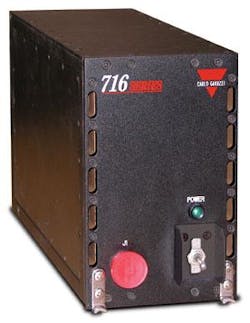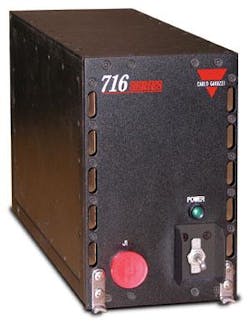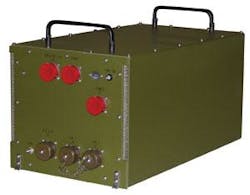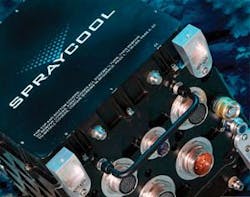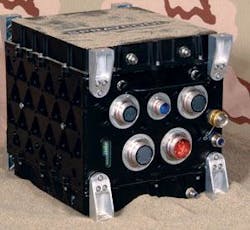Hot components and cool enclosures
Systems architects and integrators tackle thermal issues with clever chassis designs.
By Courtney E. Howard
Of all the issues that challenge the survivability of military electronics, thermal management has the greatest influence on electronics reliability, says Joe Baddeley, executive vice president of business development and marketing at electronics cooling specialist SprayCool in Liberty Lake, Wash. Some sources estimate that as much as 70 percent of all electronics failures in the military are thermally related. “Whatever the right number is,” continues Baddeley, “most everyone agrees it is high.”
A recognized rule of thumb: every 10-degree Celsius increase in temperature during continuous operation cuts electronics reliability in half, Baddeley notes. “The problem isn’t confined to just hotter components, but also thermal fatigue. As electronic components go through various duty cycles, their temperatures can vary widely if the cooling system is not well designed.”
Integral to the electronics system design—especially where thermal management and electronics cooling are concerned—is the enclosure housing the components. Today’s engineers have within reach a wealth of enclosure options using a variety of different cooling methods. One traditional approach is air cooling, with or without the use of fans; it is a method that companies such as Crystal Group Inc. in Hiawatha, Iowa, and Performance Technologies in Rochester, N.Y., continue to advance and perfect.
In the air
“Some of the electronics being manufactured are so smart that they regulate their own heat production by reducing performance,” explains Jim Shaw, vice president of engineering and operations at Crystal Group. “The [Intel] Xeon and Core 2 Duo chips we use in our rugged servers are examples of parts that throttle with power dissipation and ambient conditions.”
Intel Corp. engineers have come up with ways for their microprocessors to sense their operating temperatures and throttle back performance when they get too hot. “Desktop processors produced using the Intel NetBurst micro-architecture have a feature called Thermal Monitoring, which allows the processor to modulate its core power to stay within its specified thermal envelope,” says an Intel representative. “Throttling will be minimized in a well-designed platform.”
The challenge, Shaw explains, is putting together a thermal system that maintains performance in extreme environments—55 degrees C, for example. If the enclosure isn’t designed with sufficient thermal-management capabilities, the processors will heat up and the processor clocks will be reduced or clocks cycles will be skipped. As a result, the system as a whole—and thereby the user—takes a big performance hit.
“Crystal Group uses air over components whenever possible because it is economical and effective,” Shaw notes.
Performance Technologies has released the MTC5070 system with a scalable steel enclosure offering front-to-back cooling, an industry first for a 1U MicroTCA platform. The push-and-pull air-cooling configuration incorporates a front filter, as well as four fans in a baffle system that blow air across the boards and over the power supply. The power supply has its own fan, and four more fans at the rear of the enclosure blow air out the back. The design enables the use of various cards and processors, including those which generate a large amount of heat.
Some chips are being made in ways that are more difficult to cool, and require alternate cooling methods. “Flip chips are cavity-down wafers that put the heat load on the lid of the component,” Shaw says. “Getting the heat out is dependant on maintaining excellent contact with this surface, but this surface is harder to sink than the base of the part.” Crystal Group, in its RB11 Rugged Blade, uses a novel approach: extracting heat in two directions for the Northbridge and Core 2 chips. “Some environments—sand/dust and salt/fog—may prevent this method, but generally this is the predominant approach in ruggedized COTS [commercial off-the-shelf].”
Solidly sealed
Air cooling is often not an option in military environments, such as the Middle East, in which fine sand and dust can bring a halt to many an electronics system. In such situations, Crystal Group, for example, provides sealed servers with natural convection cooling. Shaw and his company colleagues also are designing a system with a completely self-contained (sealed) cooled cabinet.
“Thermal management of today’s military electronics continues to be a major challenge when trying to leverage COTS board technology into caustic environments,” acknowledges Jim Tierney, vice president of government systems at Carlo Gavazzi Computing Solutions in Brockton, Mass. “Typically, it will require the sealing of an enclosure to reduce or eliminate the ingress of caustic air into the system environment. This limits the cooling options available.”
Carlo Gavazzi engineers’ approach to the best thermal management solution for any given application starts with understanding all the environmental and system architecture performance requirements first, explains Steve Corbesero, vice president of engineering at Carlo Gavazzi. After understanding the system parameters and investigating which compute components can be used, they identify the cooling requirements and determine, with the use of thermal simulation tools like computational fluid dynamics (CFD) and Flowtherm—the most efficient and effective way to thermally manage the entire system.
To accomplish thermal management in the sealed electronics systems, the engineers combine several cooling methods such as conduction, re-circulating air, air over conduction, liquid, as well as heat sinks and spreaders to move the heat away from the electronics.
Cooling in cramped spaces
“In a nutshell, it is Moore’s Law in effect,” Corbesero says, summing up the reason thermal management is such a hot topic today. “As more electronics get packed into less space, there is an increase in the compute platform’s thermal density. In addition to the increase in thermal density, the operating environments of these compute platforms can require sealing them off from sand, dust, water, and other elements, and can reach well over 55 degrees C. A short service life and/or demised operational range will result if the electronics are not properly cooled and protected from the elements.”
Cooling is a considerable challenge when it comes to vehicle electronics, which must meet size, weight, and performance (SWaP) requirements. Mobile electronics—whether in ground vehicles, ships, or aircraft—must deliver high performance in a compact size.
“All these factors are true of today’s small-form-factor compute platforms that are the size of a two-slice toaster and boast enough performance to be a server for a 100-person organization where we have to thermally manage over 500 watts in a completely sealed box that is bouncing around in a Humvee in the desert,” Corbesero says.
Carlo Gavazzi personnel designed a sealed, rugged air transport rack (ATR) enclosure that went into a Humvee shelter. The ATR housed many off-the-shelf compute components that would normally be used in a desktop PC. This system is described as a video server with three Intel Core 2 Duo 2.1-gigahertz processors and six terabytes of storage. “We used a combination of the conduction, re-circulating air, and air-over-conduction cooling strategies, which were augmented with specialized heat sinks, thermal components, and spreaders.” They met the application’s performance and environment requirements, as well as the customer’s goal of deploying 35 systems in less than six months.
Vetronics cooling
Heat threatens the longevity and performance of electronics, especially vetronics, in mil-aero environments, explained Gerald Janicki, senior director at Meggitt Defense Systems Inc. in Irvine, Calif., during the 2008 Military & Aerospace Electronics Forum (MAEF 2008, www.milaeroforum.com) last March in San Diego.
“We talked to the soldiers; they want cooling,” Janicki insisted, referring to increased heat dissipation from expanded in-vehicle electronics. “Thermal management is the central issue today.”
Vetronics face several potential sources of heat, stemming from computer processors, solar loads, thermal-management systems that produce heat, the environment, and the vehicle itself, noted Janicki. “Thermal management is becoming a mission-critical function and subsystem in support of key vetronics. Thermal-management systems need to be simple, modular, and upgradeable to cost-support COTS electronics on legacy and future military platforms.”
Janicki’s recommended cooling solution also encompasses several thermal-management methods, including: ruggedized conduction-cooled cards with thermal spreaders, LFT enclosures with self-contained LFT side-wall cooling, an affordable active cooling and heating system, and modular platform integration.
“Moore’s Law is alive and well,” insists Carlo Gavazzi’s Corbesero. “It will continue to allow compute platform designers to pack more electronics into less space, which will increase the compute platform’s thermal density.” Yet, no “silver bullet” thermal-management solution exists; rather, the best solution is often a collaborative effort, he says.
Looking to liquids
“It’s everywhere we look,” Jim Robles, senior technical fellow at The Boeing Company in Seattle, said of thermal-management concerns at MAEF 2008. “Thermal management is quickly becoming a limiting design factor for future military aircraft and satellites. Future cooling demands will require an integrated thermal management strategy at the platform, subsystem, and component levels.”
Robles and his cohorts at Boeing are investigating several options, including liquid cooling. “We are not going to have any other choice than to investigate and invest in spray cooling,” predicts Robles.
For the past 15 years, SprayCool engineers have professed that processing performance density would drive liquid cooling into the military market. “It appears we weren’t wrong, just a bit early,” Baddeley quips. “It feels like liquid cooling is finally being recognized as a legitimate option for electronics thermal management.”
SprayCool enclosures, including the new Multi-Platform Enclosure (MPE), take advantage of an efficient evaporation process. A fine liquid mist sprays directly onto the hot components. The liquid, which is non-conductive and non-corrosive, can carry away five times more heat in the same volume than air, explains Baddeley. “As a closed-loop liquid cooling/heating system, the SprayCool enclosure offers the same environmental isolation benefits of a conduction-cooled enclosure, but far less air refrigeration to maintain safe component temperature operation.”
SprayCool enclosures can cool a wide range of electronics—including commercial single-board computers designed for air cooling, power electronics modules with extreme power densities, and custom RF boards that are sensitive to temperature variation—mixed within the same chassis. “This flexibility is extremely valuable to the customer, especially in retrofit situations, but also in new design environments where densification and co-location are key to SWaP reduction. Cost advantages are realized because electronics selection can be accomplished with commercial-grade components rather than temperature-extended parts.” The technology can also reduce the need for air refrigeration and, in some cases (such as aviation applications), an environmental control system (ECS).
“The ability to deploy a wide variety of electronics within one chassis, with minimal additional ECS requirements, has greatly impacted the integrators’ consideration of liquid cooling-based products,” Baddeley admits. “It is infectious once you get past the initial shock of cooling your electronics with liquid—even if it is a dielectric. Electronics designers have so much more freedom to select existing electronics and/or design to new performance densities never before considered.”
Cooling standardization
As power dissipation and power densities continue to increase, the design of the enclosure is critical, says Mike Gust, manager of mechanical engineering services at Mercury Computer Systems in Chelmsford, Mass. “For air cooling, the enclosure design has to be such that it can supply the required air, both in terms of volume and pressure drop over temperature and altitude. We have a heavy reliance on analytical tools to ensure we have optimized the thermal solution for both the module and the enclosure. For conduction cooling, the enclosure design is even more critical, due to the fact that the traditional conduction-cooled enclosures are power limited.”
For these and other reasons, Mercury engineers customize enclosure designs to each application to handle thermal loads properly. They typically design the entire cooling infrastructure for enclosures with complex cooling requirements.
“For our larger systems, we primarily use air cooling,” Gust explains. “For rugged deployed applications, we ship more conduction-cooled product. Given the required power densities and component temperature limitations, we are starting to look at liquid cooling.”
Mercury’s cooling method, a technology called finely managed air, affects the module design and the enclosure design to achieve the desired level of thermal performance, says Gust. “A lot of heat can be moved with less air, when compared to more traditional air-cooling implementations. A portion of this technology is licensed as part of the VITA 48 air-cooling standard.” Mercury has served as the working group chairman and as the draft editors for the base specification and the dot specifications for air cooling and conduction cooling.
“VITA 48 is the first industry standard to address the standardization of all the major cooling methods—conventional air cooling, conduction cooling, two forms of liquid cooling, and air-flow-thru cooling,” Gust explains. “The goal of the standard is to have one circuit board that can be used in each of the cooling methods simply by changing its mechanical wrapper.
“It provides a two-level maintenance capability, which is becoming a prevalent requirement for deployed applications,” says Gust. “The ability to be able to maintain a common circuit board that can be used in different cooling methods by changing the mechanical wrapper is a big benefit. It increases availability, and can reduce lead times and NRE charges.”
Power density is going to drive the need for thermal management, predicts Gust. “As components become smaller, their power density increases. In order to manage the heat, there continues to be a need for innovation in the thermal-management space. The trend is for smaller form-factor boards that have limited space available for thermal-management solutions. As this continues, spray cooling and liquid cooling will rise in prominence.”
Combined cooling
“With today’s diverse range of requirements and deployed locations, one [cooling] method does not stand out as a clear solution for all,” Tierney says. “There is no set thermal solution, as each requirement brings forth its own set of obstacles and challenges and requires the cooling method to be integral to all other technical factors internal and external to the system.”
The best solution incorporates the ability to tune and optimize a cooling method for the specific application, Tierney says. This approach enables engineers to stay flexible and in synch with customers’ performance and price targets. “Understanding of the complete system and, to an extent, having control over the definition to that system is extremely important to determining the best cooling method.
“The future will continue to present thermal challenges. As the package size for processors continues to decrease, so will the requirement for the overall electronics enclosure decrease,” Tierney predicts. “Smaller enclosures will restrict overall surface area, placing demands on cooling methods. It is no longer a black-and-white thermal solution for a given application. What may work on one solution may require a hybrid approach that will meld two or more cooling methods to achieve optimal thermal performance.”
